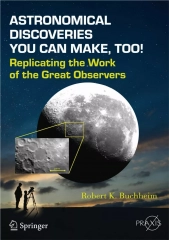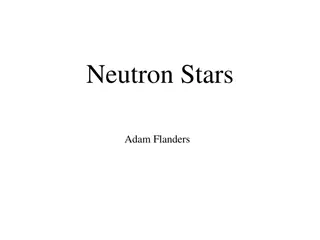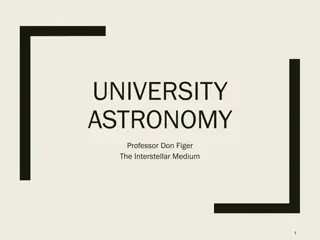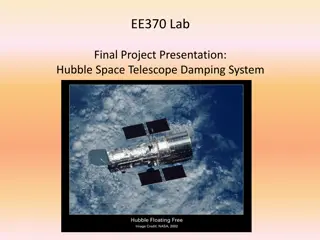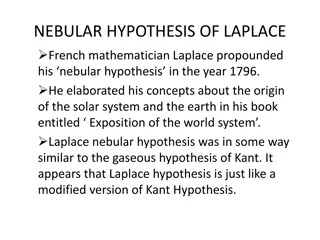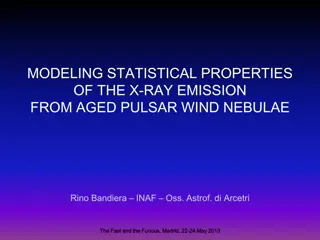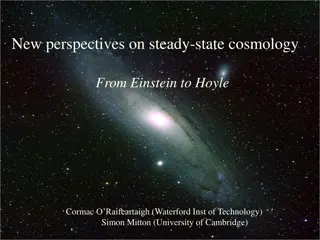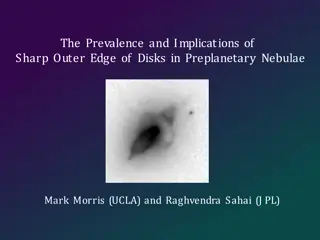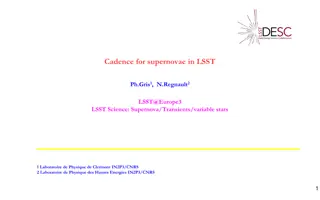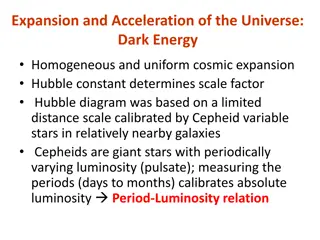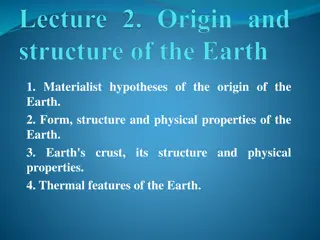Understanding Nebulae: From Kant's Proposal to Hubble's Discoveries
In 1755, Kant proposed that nebulae are island universes, sparking a debate on their nature within or outside our galaxy. Shapley and Curtis debated whether spiral nebulae were rotating systems like our Milky Way. Hubble's observations of the Andromeda Nebula led to the realization that it is a galaxy. His discovery of the distance to M31 settled the debate in 1924. The classification of galaxies by Hubble further enhanced our understanding of nebulae and their various forms.
Download Presentation

Please find below an Image/Link to download the presentation.
The content on the website is provided AS IS for your information and personal use only. It may not be sold, licensed, or shared on other websites without obtaining consent from the author. Download presentation by click this link. If you encounter any issues during the download, it is possible that the publisher has removed the file from their server.
E N D
Presentation Transcript
What are nebulae?? 1755 Kant proposed nebulae are island universes Are Nebulae within or outside of our galaxy?? Nebula comes from a Greek word meaning Cloud
April 1920, National Academy of Sciences , Washington, DC Harlow Shapley (had determined size of Milky Way Galaxy) pushed that nebulae were relatively close by objects. Heber Curtis championed view that spiral nebulae were rotating systems of stars like our own galaxy. Debate was heated but eventually a draw as neither side could provide convincing evidence for either view
The Andromeda Nebula The Great Nebula in Andromeda, also known as M31, can be seen with even a small telescope. Edwin Hubble was the first to demonstrate that M31 is actually a galaxy that lies far beyond the Milky Way. M32 and M110 are two small satellite galaxies that orbit M31.
Edwin Hubble Oct 6, 1923 Historic Photo of M31(Andromeda Galaxy) Discovered a Cepheid variable star (thought it was a nova) Used formulas to determine the galaxy was 750 kpc (2.5 million ly) away and it was 70 kpc in diameter (recall Milky Way is only 50 kpc in diameter) Nebula was not Near by
December 30, 1924 Hubble presents his findings to American Astronomical Society Shapley-Curtis Debate effectively settled The Universe is a big place!!
Tidal forces from Milky Way believed to be source of star formation in the two Magellanic Clouds
Hubble Classification of Galaxies 4 Classes of Galaxies S Spirals SB Barred Spirals E Ellipticals Irr Irregulars
Spirals Arched lanes of stars Spiral Arms containing young hot blue stars and associated H II regions Strong heavy elements present so lots of Population I stars in spiral arms Central bulges low star formation rate dominated by Population II stars
Spirals Sub-divided Sa Large central bulges ~4% of galactic mass in gas and dust Sb Medium sized central bulges ~8% of galactic mass in gas and dust Sc Small central bulges ~25% of galactic mass in gas and dust
Barred Spiral Galaxies Spirals originate at the end of a bar shaped region which passes through the nucleus of the galaxy rather than originating from the nucleus itself. Hubble again applied a, b, and c to rate the size of the central bulge with a being largest and c being smallest As with ordinary spirals this difference of a through c may be due to amount of gas and dust in the galaxy.
Bars appear to form naturally in Spirals from computer simulations Barred Spirals outnumber Spirals by about two to one Milky Way may be Barred Spiral
Bars appear to form naturally in Spirals from computer simulations Barred Spirals outnumber Spirals by about two to one Milky Way may be Barred Spiral A theory why all Spirals don t have bars proposes that if a galaxy is surrounded by a large enough halo of Dark Matter bar will not form. Milky Way may have such a halo?
Ellipticals No Spiral Arms Further sub-divided by numbers E0 is roundest E7 is flattest Category based on observation from Earth, may not be completely accurate Mostly Population II stars, little to no new star formation occurring in these galaxies
Giant Elliptical Galaxies The Virgo cluster is a rich, sprawling collection of more than 2000 galaxies about 17 Mpc (56 million ly) from Earth. Only the center of this huge cluster appears in this photograph. The two largest members of this cluster are the giant elliptical galaxies M84 and M86. These galaxies have angular sizes of 5 to 7 arcmin.
A Dwarf Elliptical Galaxy This diffuse cloud of stars is a nearby E4 dwarf elliptical called Leo I. It actually orbits the Milky Way at a distance of about 180 kpc (600,000 ly). Leo I is about 1 kpc (3000 ly) in diameter but contains so few stars that you can see through the galaxy s center.
A Lenticular Galaxy NGC 2787 is classified as a lenticular galaxy because it has a disk but no discernible spiral arms. Its nucleus displays a faint bar (not apparent in this image), so NGC 2787 is denoted as an SB0 galaxy. It lies about 7.4 Mpc (24 million ly) from Earth in the constellation Ursa Major.
Hubbles Tuning Fork Diagram Edwin Hubble s classification of regular galaxies is shown in his tuning fork diagram. An elliptical galaxy is classified by how flattened it appears. A spiral or barred spiral galaxy is classified by the texture of its spiral arms and the size of its central bulge. A lenticular galaxy is intermediate between ellipticals and spirals. Irregular galaxies do not fit into this simple classification scheme.
Hubble Tuning Fork Diagram Hubble originally proposed that it represented evolution of galaxies Ellipticals would evolve into Spirals Ellipticals have little to no rotation Modern view is diagram represents grouping by rotation Ellipticals are galaxies with little to no rotation Spirals class c have greatest rotations
Types of Irregular Galaxies Type I Many OB associations and H II regions Type II Asymmetrical shapes implying they resulted from collisions with other galaxies or have violent activity occur within their nucleus
Grouping of Galaxies Groups of Galaxies are called Clusters Rich Clusters have many galaxies Poor Clusters have few galaxies and are sometimes called groups Poor Clusters outnumber Rich Clusters Milky Way (our galaxy) is part of the Local Group ~30 galaxies (most are dwarf ellipticals)
Categorizing Clusters Regular Spherical in shape obvious concentration of galaxies at its center Irregular Not Regular! Local Group is irregular
The Hercules Cluster https://apod.nasa.gov/apod/ap140625.html
The Hercules Cluster This irregular cluster of galaxies is about 200 Mpc (650 million ly) from Earth. The Hercules cluster contains many spiral galaxies, often associated in pairs and small groups.
https://apod.nas a.gov/apod/ap14 0625.html
Shape of Clusters Shape of Cluster is determined by which type of galaxies dominate its make-up Regular Clusters have mostly ellipticals and lenticular galaxies Irregular Clusters have a more even mixture of galaxies
The Local Group http://www.atlasoftheuniverse.com/localgr.html
The Local Group This illustration shows the relative positions of the galaxies that comprise the Local Group, a poor, irregular cluster of which our Galaxy is part. (The blue rings represent the plane of the Milky Way s disk; 0 is the direction from Earth toward the Milky Way s center. Solid and dashed lines point to galaxies above and below the plane, respectively.) The largest and most massive galaxy in the Local Group is M31, the Andromeda Galaxy; in second place is the Milky Way, followed by the spiral galaxy M33. Both the Milky Way and M31 are surrounded by a number of small satellite galaxies.
The Canis Major Dwarf Discovered in 2003, this dwarf elliptical galaxy is actually slightly closer to Earth than is the center of the Milky Way Galaxy. This illustration shows the stream of material left behind by the Canis Major Dwarf as it orbits the Milky Way. This material is torn away by the Milky Way s tidal forces.
The Coma Cluster This rich, regular cluster is about 90 Mpc (300 million light-years) from the Earth. Almost all of the spots of light in this image are individual galaxies of the cluster. Two giant elliptical galaxies, NGC 4889 and NGC 4874, dominate the center of the cluster. The bright star at the upper right is within our own Milky Way Galaxy, a million times closer than any of the galaxies shown here.
Nearby Clusters of Galaxies This illustration shows a sphere of space 800 million ly (250 Mpc) in diameter centered on the Earth in the Local Group. Each spherical dot represents a cluster of galaxies. To better see the three-dimensionality of this figure, colored arcs are drawn from each cluster to the green plane, which is an extension of the plane of the Milky Way outward into the universe. Note that clusters of galaxies are unevenly distributed here, as they are elsewhere in the universe.
Structure in the Nearby Universe This composite infrared image from the 2MASS (Two-Micron All-Sky Survey) project shows the light from 1.6 million galaxies. In this image, the entire sky is projected onto an oval; the blue band running vertically across the center of the image is light from the plane of the Milky Way. Note that galaxies form a lacy, filamentary structure. Note also the large, dark voids that contain few galaxies.
Groupings of Clusters Clusters group to form Superclusters Typically dozens of clusters spread over a a region of space 30 Mpc across
1980s mapping of clusters Use redshifts to get a 3-dimensional mapping of galaxy locations. Discovery of spherical voids which are either empty or contain Hydrogen clouds or dim galaxies Voids are about 30 to 120 Mpc in diameter Galaxies are concentrated in Sheets on the surfaces surrounding and between the Voids Think soapsuds in a sink with soapfilms surrounding air bubbles
Great Walls of Galaxies In the 3-D map we find two large structures the Great Wall in the northern part of the map and the Southern Wall in the southern part of the map. Great Wall extends ~150 Mpc along the arc and 5 Mpc perpendicular to the surface Southern Wall extends ~100 Mpc On scales above 100 Mpc, distribution of galaxies appears to be fairly uniform
X-ray Emission from a Cluster of Galaxies (a) An X-ray image of this cluster of galaxies shows emission from hot gas between the galaxies. The gas was heated by collisions between galaxies within the cluster. (b) The galaxies themselves are too dim at X-ray wavelengths to be seen in (a), but are apparent at visible wavelengths. This cluster, one of many cataloged by the UCLA astronomer George O. Abell, is about 300 Mpc (1 billion ly) from Earth in the constellation Serpens.
The M81 Group (a) The starburst galaxy M82 (see Figure 24-26) is part of a cluster of about a dozen galaxies. This wide-angle visible-light photograph shows the three brightest galaxies of the cluster. The area shown is about 1 (b) This false-color radio image of the same region, created from data taken by the Very Large Array, shows streamers of hydrogen gas that connect the three bright galaxies as well as several dim ones. across.
21 cm radiation show connections of Hydrogen gas between galaxies indicating previous interactions As with the M 82, M 81 and NGC 3077, Milky Way and Large Magellanic Cloud have similar Hydrogen gas connections
Colliding Galaxies? Collisions produce hot intracluster gas at temperatures between 107 and 108 k Collisions unlikely to result in Star on Star collisions, too much empty space between Starburst galaxies due to compression of gas within the galaxy causing star birth
The Mice https://apod.nasa.gov/apod/ap150201.html
The Antennae Galaxies http://apod.nasa.gov/apod/ap971022.html
M64: The Sleeping Beauty Galaxy -Gas rotates opposite direction of the stars!! http://antwrp.gsfc.nasa.gov/apod/ap040211.html
Warped Spiral Galaxy ESO 510-13 (150 Million ly) http://antwrp.gsfc.nasa.gov/apod/ap030607.html
Warped Spiral Galaxy ESO510-13 (150 Million ly) http://antwrp.gsfc.nasa.gov/apod/ap990512.html
NGC 1410/1409: Intergalactic Pipeline http://antwrp.gsfc.nasa.gov/apod/ap010112.html
Cluster is 8 Billion ly away http://antwrp.gsfc.nasa.gov/apod/ap990722.html
Sagittarius Dwarf to Collide with Milky Way http://antwrp.gsfc.nasa.gov/apod/ap980216.html
Colliding Galaxies Galactic deformations due to tidal forces Stars may be ejected from galaxy Often the colliding galaxies repeatedly collide until they merge and form one new galaxy Galactic Cannibalism!! Milky Way on track to collide with Andromeda (M 31) in ~ 6 billion years
Third Method to form Spiral Arms? Close encounters between galaxies may provide another way to form spiral arms in addition to Density Wave model or Self-Propagating Star Formation http://phys.org/news/2013-04-insights- spiral-galaxies-arms.html


![get⚡[PDF]❤ The Hubble Space Telescope: From Concept to Success (Springer Praxis](/thumb/21514/get-pdf-the-hubble-space-telescope-from-concept-to-success-springer-praxis.jpg)
